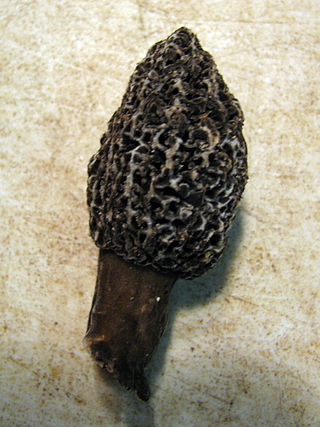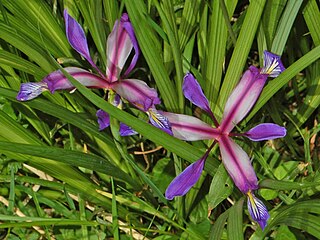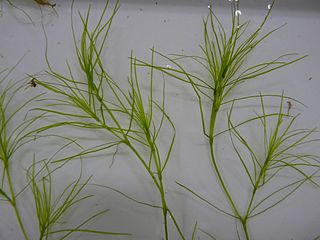Related Research Articles

Matthiola is a genus of flowering plant in the mustard family Brassicaceae. It is named after Italian naturalist Pietro Andrea Mattioli (1501–1577). The genus contains about 50 species of annual, biennial and perennial herbaceous plants and subshrubs. Many are cultivated for their heavily scented, colorful flowers.

Paulownia tomentosa, common names princess tree, empress tree, or foxglove-tree, is a deciduous hardwood tree in the family Paulowniaceae, native to central and western China. It is an extremely fast-growing tree with seeds that disperse readily, and is a persistent exotic invasive species in North America, where it has undergone naturalisation in large areas of the Eastern US. P. tomentosa has also been introduced to Western and Central Europe, and is establishing itself as a naturalised species there as well.

Uncaria tomentosa is a woody vine found in the tropical jungles of South and Central America. It is known as cat's claw or uña de gato in Spanish because of its claw-shaped thorns. The plant root bark is used in herbalism for a variety of ailments, and is sold as a dietary supplement.
The Wych Elm cultivar Ulmus glabra 'Tomentosa' was first listed as Ulmus tomentosa by Kirchner in Arboretum Muscaviense (1864). The Hesse Nursery of Weener, Germany, distributed an Ulmus montana tomentosa in the 1930s. Green listed it as a wych elm cultivar.

The Mexican alligator lizard, also known as the green arboreal alligator lizard, is an endangered species of lizard endemic to the Sierra Madre de Oaxaca highlands of Mexico. It can be found in the states of Puebla, Veracruz, and Oaxaca. It was originally described under the genus Gerrhonotus as Gerrhonotus gramineus by Edward D. Cope in 1864.
Ulmus wallichiana var. tomentosa was identified by Melville & Heybroek after the latter's expedition to the Himalaya in 1960.

Stellaria graminea is a species of flowering plant in the family Caryophyllaceae known by the common names common starwort, grass-leaved stitchwort, lesser stitchwort and grass-like starwort.

Odorrana graminea, the large odorous frog, inhabits fast-flowing streams in elevated mountainous regions of Southern China and Northern Indochina. It is one of 56 species in the genus Odorrana. Male O. graminea are noted for their ultrasonic call characteristics and are one of three frog species able to detect ultrasonic frequencies, likely evolved to facilitate communication amidst noisy streams and waterfalls. Studies on O. graminea courtship vocalizations suggest female preference for increased proportion of nonlinear vocal phenomena (NLP).

Tilia tomentosa, known as silver linden in the US and silver lime in the UK, is a species of flowering plant in the family Malvaceae, native to southeastern Europe and southwestern Asia, from Romania and the Balkans east to western Turkey, occurring at moderate altitudes.

Arctostaphylos tomentosa is a species of manzanita known by the common name woollyleaf manzanita or woolley manzanita. This shrub is endemic to California.

Prunus tomentosa is a species of Prunus native to northern and western China, Korea, Mongolia, and possibly northern India. Common names for Prunus tomentosa include Nanjing cherry, Korean cherry, Manchu cherry, downy cherry, Shanghai cherry, Ando cherry, mountain cherry, Chinese bush cherry, and Chinese dwarf cherry.

Fadogia is a genus of flowering plants in the family Rubiaceae. The genera Rytigynia and Fadogia form a strongly supported clade but neither of these genera is monophyletic.

Morchella tomentosa, commonly called the gray, fuzzy foot, or black foot morel, is a species of fungus in the family Morchellaceae. M. tomentosa is a fire-associated species described from western North America, formally described as new to science in 2008.

Iris graminea is a species of flowering plant belonging to the subgenus Limniris of the genus Iris, in particular the series Spuriae. It is a rhizomatous perennial, with purple or violet blue flowers almost hidden by narrow, grass-like leaves, and a plum scented fragrance. It is cultivated as an ornamental plant in temperate regions. It has several common names, including grass-leaved flag, grass leaved iris, plum iris and plum tart iris. This species naturally occurs in the southern half of Europe, from Spain and France in the West to Russia and the Caucasus in the East.

Najas graminea, also known as ricefield water-nymph is a species of aquatic plant found in freshwater habitats, especially still or slow-moving waters, like ponds and rice fields. It grows to a maximum length of 30 cm. The flowers are monoecious. The flowering season is from July to September.</ref>

Gilliesia is a genus in the family Amaryllidaceae. The entire genus is native to Chile and Argentina.

Sagittaria graminea, the grassy arrowhead or grass-leaved arrowhead, is an aquatic plant species native to eastern North America.
Graminea is a genus of longhorn beetles of the subfamily Lamiinae.

Persoonia graminea is a species of flowering plant in the family Proteaceae and is endemic to the south-west of Western Australia. It is an erect to weak, low-lying shrub with long, linear leaves and flowers in groups of ten to twenty-five on a rachis up to 220 mm (8.7 in) long.

Thelymitra graminea, commonly called the shy sun orchid, is a species of orchid in the family Orchidaceae and is endemic to the south-west of Western Australia. It has a single leathery, channelled leaf and up to ten relatively small blue, self-pollinating flowers with white, toothbrush-like tufts on the top of the anther.
References
- ↑ BioLib.cz - Graminea tomentosa. Retrieved on 8 September 2014.